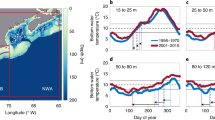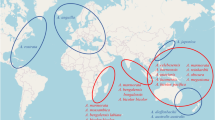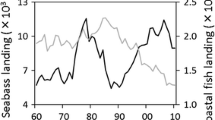Abstract
Hydrographic conditions and distributions of juvenile temperate sea bass Lateolabrax japonicus were observed in early spring from 2009 to 2012 in the Yura River estuary, which is highly stratified due to its small tides and consequent seawater intrusion into the bottom layer of the river as a salt wedge. In all four studied years, the upstream expansion of their distribution coincided with the timing of the salt wedge intrusion from the lower to upper estuary, indicating that juvenile fish used salt wedge intrusions to ascend the estuary in early spring. However, juveniles sometimes remained in the nearshore area even when the salt wedge intrusion had already occurred, indicating that other triggers are also likely to be necessary. We therefore evaluated the effects of temperature on upstream migration behaviors. The relationship between the mean temperature they experienced from hatch until starting the ascent and mean age of each cohort at the upstream migration fitted with the law of effective cumulative temperature. Most cohorts ascended the river at an effective cumulative temperature of approximately 500 °C–days. This suggests that higher temperatures would lead to a shorter period prior to the upstream migration.










Similar content being viewed by others
References
Arayama K, Imai J, Kanou K, Kohno H (2002) Ichthyofauna of surf zones in the outer Tokyo Bay. La mer 40:59–70 (in Japanese with English abstract)
Benoît HP, Pepin P, Brown JA (2000) Patterns of metamorphic age and length in marine fishes, from individuals to taxa. Can J Fish Aquat Sci 57:856–869
Bohlin T, Dellefors C, Faremo U (1993) Timing of sea-run brown trout (Salmo trutta) smolt migration: effects of climatic variation. Can J Fish Aquat Sci 50:1132–1136
Boubée JA, Mitchell PC, Chisnall BL, West DW, Bowman EJ, Haro A (2001) Factors regulating the downstream migration of mature eels (Anguilla spp.) at Aniwhenua dam, Bay of Plenty, New Zealand. New Zeal J Mar Fresh Res 35:121–134
Dyer KR (1973) Estuaries: a physical introduction. Wiley, London
Fuji T, Kasai A, Suzuki KW, Ueno M, Yamashita Y (2010) Freshwater migration and feeding habits of juvenile temperate seabass Lateolabrax japonicus in the stratified Yura River estuary, the Sea of Japan. Fish Sci 76:643–652
Fuji T, Kasai A, Suzuki KW, Ueno M, Yamashita Y (2011) Migration ecology of juvenile temperate seabass Lateolabrax japonicus: a carbon stable-isotope approach. J Fish Biol 78:2010–2025
Fuji T, Kasai A, Ueno M, Yamashita Y (2014) Growth and migration patterns of juvenile temperate seabass Lateolabrax japonicus in the Yura River estuary, Japan—combination of stable isotope ratio and otolith microstructure analyses. Environ Biol Fish 97:1221–1232
Fuji T, Kasai A, Ueno M, Yamashita Y (2016a) The importance of estuarine production of large prey for the growth of juvenile temperate seabass (Lateolabrax japonicus). Estuar Coasts 39:1208–1220
Fuji T, Kasai A, Ueno M, Yamashita Y (2016b) Importance of estuarine nursery areas for the adult population of the temperate seabass Lateolabrax japonicus, as revealed by otolith Sr:Ca ratios. Fish Oceanogr 25:448–456
Fujita S (2004) Ecological study on larvae and juveniles of the two sea basses and the three sparines occurring in the Shimanto Estuary, Japan. Bull Mar Sci Fish Kochi Univ 23:1–57 (in Japanese with English abstract)
Fujita S, Kinoshita I, Takahashi I, Azuma K (1988) Seasonal occurrence and food habits of larvae and juveniles of two temperate basses in the Shimanto Estuary, Japan. Jpn J Ichthyol. 35:365–370
Gibson RN (1997) Behavior and the distribution of flatfishes. J Sea Res 37:241–256
Hatanaka M, Sekino K (1962) Ecological studies on the Japanese seabass, Lateolabrax japonicus—1. Feeding habit. Nippon Suisan Gakkaishi 28:851–856 (in Japanese with English abstract)
Hayashi B, Kiyono S (1978) Ecological studies on the Japanese sea bass, in the western Wakasa Bay—2. The food habitat and growth of Japanese seabass in yearling. Rep Kyoto Inst Ocean Fish Sci 2:109–116 (in Japanese)
Hibino M, Ohta T, Kinoshita I, Tanaka M (2002) Fish larvae and juveniles occurring in the littoral zone of a tidal flat, in the bottom of Ariake Bay, Japan. J Ichthyol 49:109–120
Hibino M, Ohta T, Isoda T, Nakayama K, Tanaka M (2007) Distribution of Japanese temperate bass, Lateolabrax japonicus, eggs and pelagic larvae in Ariake Bay. Ichthyol Res 54:367–373
Hirai N (2002) Physiology of osmoregulation. In: Tanaka M, Kinoshita I (eds) Temperate bass and biodiversity. Koseisha-koseikaku, Tokyo, pp 103–113 (in Japanese)
Hirai N, Tagawa M, Kaneko T, Seikai T, Tanaka M (1999) Distributional changes in branchial chloride cells during freshwater adaptation in Japanese sea bass Lateolabrax japonicus. Zool Sci 16:43–49
Hoffman JC, Limburg KE, Bronk DA, Olney JE (2008) Overwintering habitats of migratory juvenile American shad in Chesapeake Bay. Env Biol Fish 81:329–345
Ichthyological Society of Japan (2003) Guidelines for the use of fishes in research. The Ichthyological Society of Japan, Japan. http://www.fish-isj.jp/english/guidelines.html
Islam MS, Hibino M, Tanaka M (2007) Tidal and diurnal variations in larval fish abundance in an estuarine inlet in Ariake Bay, Japan: implication for selective tidal stream transport. Ecol Res 22:165–171
Islam MS, Ueno M, Yamashita Y (2009) Otolith microstructure of Japanese seabass larvae and juveniles: interpretation and utility for ageing. J Appl Ichthyol 25:423–427
Iwamoto Y, Morita T, Shoji J (2010) Occurrence and feeding habits of Japanese seabass Lateolabrax japonicus larvae and juveniles around the Ohta River estuary, upper Hiroshima Bay, Seto Inland Sea. Nippon Suisan Gakkaishi 76:841–848 (in Japanese with English abstract)
Iwata M, Tsuboi H, Yamashita T, Amemiya A, Yamada H, Chiba H (2003) Function and trigger of thyroxine surge in migrating chum salmon Oncorhynchus keta fry. Aquaculture 222:315–329
Jansen T, Gislason H (2011) Temperature affects the timing of spawning and migration of North Sea mackerel. Cont Shelf Res 31:64–72
Kaeriyama M (1989) Development and growth of the genus Oncorhynchus 1. Concepts and effective accumulative temperature on development and growth. Tech Rep Hokkaido Salmon Hatch 158:22–28
Kasai A, Kurikawa Y, Ueno M, Robert D, Yamashita Y (2010) Salt-wedge intrusion of seawater and its implication for phytoplankton dynamics in the Yura Estuary, Japan. Estuar Coast Shelf Sci 86:408–414
Kinoshita I (2002) Diversity of the early life history. In: Tanaka M, Kinoshita I (eds) Temperate bass and biodiversity. Koseisha-koseikaku, Tokyo, pp 79–90 (in Japanese)
Kusuda R (1963) An ecological study of the anadromous “ayu” Plecoglossus altivelis T. et S.—2. Seasonal variations in the composition of the anadromous ayu schools in the river Okumo, Kyoto. Nippon Suisan Gakkaishi 29:822–827 (in Japanese with English abstract)
Kuwatani Y (1962) The comprehensive study for fish banks related to the ecology of temperate seabass. Ann Rep Kyoto Prefect Fish Exp 8:1–124 (in Japanese)
Makino N, Matumaru Y, Tanaka M (2003) Effects of temperature and salinity on egg development of the Japanese sea bass, Lateolabrax japonicus. Aquac Sci 51:55–64 (in Japanese with English abstract)
Matsumiya Y, Mitani T, Tanaka M (1982) Changes in distribution pattern and condition coefficient of the juvenile Japanese sea bass with the Chikugo River ascending. Nippon Suisan Gakkaishi 48:129–138 (in Japanese with English abstract)
McCormick SD, Hansen LP, Quinn TP, Saunders RL (1998) Movement, migration, and smolting of Atlantic salmon (Salmo salar). Can J Fish Aquat Sci 55:77–92
Nakamura T, Kasuya K (2004) Forecasting of the first ascending day and the number of ascending schools of amphidromous ayu Plecoglossus altivelis in the Naka River, Tochigi Prefecture, central Japan. Nippon Suisan Gakkaishi 70:288–296 (in Japanese with English abstract)
Nakane Y, Suda Y, Sano M (2010) Food habits of fishes on an exposed sandy beach at Fukiagehama, South-West Kyushu Island, Japan. Helgol Mar Res 65:123–131
North EW, Houde ED (2001) Retention of white perch and striped bass larvae: biological-physical interactions in Chesapeake Bay estuarine turbidity maximum. Estuaries 34:756–769
Ohmi H (2002) Juvenile ecology in Yura river estuary in Wakasa Bay. In: Tanaka M, Kinoshita I (eds) Temperate bass and biodiversity. Koseisha-koseikaku, Tokyo, pp 44–53 (in Japanese)
Shoji J, Tanaka M (2006) Influence of spring river flow on the recruitment of Japanese seaperch Lateolabrax japonicus into the Chikugo estuary, Japan. Sci Mar 70S2:159–164
Shoji N, Sato K, Ozaki M (2002) Distribution and utilization of the stock. In: Tanaka M, Kinoshita I (eds) Temperate bass and biodiversity. Koseisha-koseikaku, Tokyo, pp 9–20 (in Japanese)
Shoji J, Ohta T, Tanaka M (2006) Effects of river flow on larval growth and survival of Japanese seaperch Lateolabrax japonicus (Pisces) in the Chikugo River estuary, upper Ariake Bay. J Fish Biol 69:1662–1674
Solomon DJ (1978) Migration of smolts of Atlantic salmon (Salmo salar L.) and sea trout (Salmo trutta L.) in a chalk stream. Env Biol Fish 3:223–229
Suzuki KW, Kasai A, Ohta T, Nakayama K, Tanaka M (2008) Migration of Japanese temperate bass Lateolabrax japonicus juveniles within the Chikugo River estuary revealed by δ13C analysis. Mar Ecol Prog Ser 358:254–256
Tamura Y, Moteki M, Yokoo T, Kohno H (2013) Occurrence patterns and ontogenetic intervals based on the development of swimming- and feeding-related characters in larval and juvenile Japanese sea bass (Lateolabrax japonicus) in Tokyo Bay. La mer 51:13–29
Trudgill DL, Honek A, Li D, Van Straalen NM (2005) Thermal time—concepts and utility. Ann Appl Biol 145:1–14
Tsukamoto K, Kajihara T (1973) Swimming speed and ability of fish. Fish Eng 10:31–36
Tsukamoto K, Miller MJ, Kotake A, Aoyama J, Uchida K (2009) The origin of fish migration: the random escapement hypothesis. In: Haro AJ, Smith KL, Rulifson RA, Moffitt CM, Klauda RJ, Dadwell MJ, Cunjak RA, Cooper JE, Beal KL, Avery TS (eds) Challenges for diadromous fishes in a dynamic global environment. American Fisheries Society Symposium vol 69, Bethesda, pp 45–61
Uchida K, Tsukamoto K, Kajihara T (1990) Effects of environmental factors on jumping behavior of the juvenile ayu Plecoglossus altivelis with special reference to their upstream migration. Nippon Suisan Gakkaishi 56:1393–1399
Watanabe T (1965) Ecological distribution of eggs of common sea bass, Lateolabrax japonicus (Cuvier) in Tokyo Bay. Nippon Suisan Gakkaishi 31:585–590 (in Japanese with English abstract)
Watanabe Y, Kawamura T, Yamashita Y (2018) Introduction: the coastal ecosystem complex as a unit of structure and function of biological productivity in coastal areas. Fish Sci 84. https://doi.org/10.1007/s12562-018-1176-7
Yamashita Y, Tsuruta Y, Yamada H (1996) Transport and settlement mechanisms of larval stone flounder, Kareius bicoloratus, into nursery grounds. Fish Oceangr 5:194–204
Yamazaki Y (2002) Effectiveness of hatchery-raised juveniles released to a brackish lake Hinuma. In: Tanaka M, Kinoshita I (eds) Temperate bass and biodiversity. Koseisha-koseikaku, Tokyo, pp 32–43 (in Japanese)
Yamazaki T, Watanabe T, Taga M (2005) Current observations at the mouth of Yura River. Tech Bull Hydrogr Oceanogr 23:112–118 (in Japanese)
Yano I, Ogawa Y (1981) Swimming speeds of larvae and juvenile of red sea bream, Chrysophrys major. Bull Natl Res Inst Aquac 2:49–54 (in Japanese with English abstract)
Zydlewski GB, Haro A, McCormick SD (2005) Evidence for cumulative temperature as an initiating and terminating factor in downstream migratory behavior of Atlantic salmon (Salmo salar) smolts. Can J Fish Aquat Sci 62:68–78
Acknowledgements
We would like to express our sincere gratitude to Dr. Masahiro Ueno for his creative comments and help with samplings. This study was partly supported by the Coastal Ecosystem Complex Project of the Ocean Resource Use Promotion Technology Development Program, MEXT of Japan.
Author information
Authors and Affiliations
Corresponding author
Additional information
This article is sponsored by the Coastal Ecosystem Complex Project of the Ocean Resource Use Promotion Technology Development Program, the Ministry of Education, Culture, Sports, Science and Technology, Japan.
Rights and permissions
About this article
Cite this article
Fuji, T., Kasai, A. & Yamashita, Y. Upstream migration mechanisms of juvenile temperate sea bass Lateolabrax japonicus in the stratified Yura River estuary. Fish Sci 84, 163–172 (2018). https://doi.org/10.1007/s12562-017-1167-0
Received:
Accepted:
Published:
Issue Date:
DOI: https://doi.org/10.1007/s12562-017-1167-0




